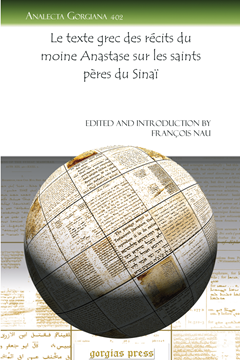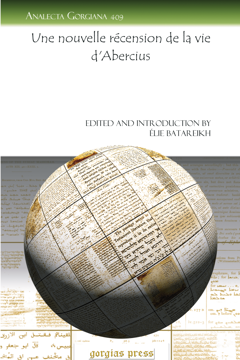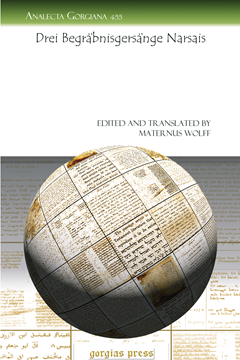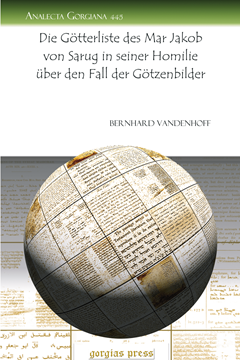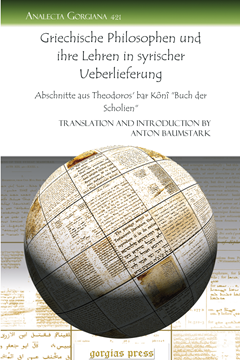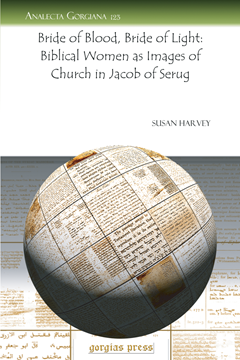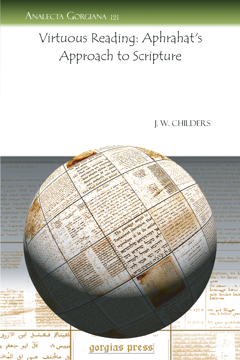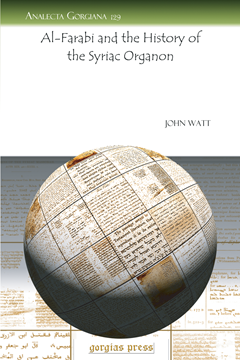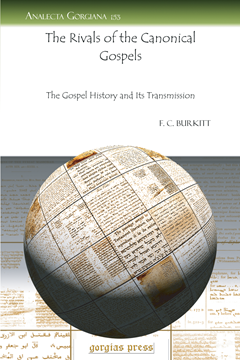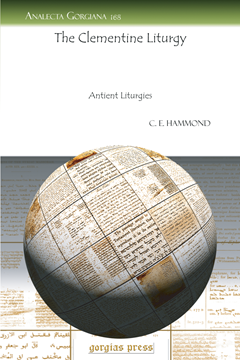Analecta Gorgiana
Analecta Gorgiana is a collection of long essays and short monographs which are consistently cited by modern scholars but previously difficult to find because of their original appearance in obscure publications. Carefully selected by a team of scholars based on their relevance to modern scholarship, these essays can now be fully utilized by scholars and proudly owned by libraries.
The Use of the Optative in the Edda
By Tenney Frank
Series: Analecta Gorgiana 388
ISBN: 978-1-60724-637-4
Tenney Frank's review and discussion of the uses of the optative in the Edda sagas of Iceland.
$37.00 (USD) $22.20 (USD)
Recognition Scenes in Greek Literature
Series: Analecta Gorgiana 396
ISBN: 978-1-60724-645-9
Prof. Perrin uses Aristotle's Poetics to classify and analyze the various sorts of recognition scenes found in surviving Greek literature.
$37.00 (USD) $22.20 (USD)
Virgil's Georgics and the British Poets
Series: Analecta Gorgiana 394
ISBN: 978-1-60724-643-5
Wilfred Mustard finds references to Vergil's Georgics in a variety of English authors from the 15th to the 19th century.
$37.00 (USD) $22.20 (USD)
Abû-l-Barakats "griechisches" Verzeichnis der 70 Jünger
Edited with an Introduction by Anton Baumstark
Series: Analecta Gorgiana 406
ISBN: 978-1-60724-681-7
Abu-al-Barakat published two versions of the list of seventy disciples sent out by Jesus. Anton Baumstark presents here the Arabic text, along with a critical Latin version, of Barakat’s list that was allegedly translated from a Greek original.
$37.00 (USD) $22.20 (USD)
Le texte grec des récits du moine Anastase sur les saints pères du Sinaï
Edited with an Introduction by François Nau
Series: Analecta Gorgiana 402
ISBN: 978-1-60724-676-3
François Nau collated various manuscripts containing stories about the holy fathers of Sinai and presents here the critical and annotated text. These stories offer otherwise unknown information about St. John Climacus and include useful historical and geographic details.
$37.00 (USD) $22.20 (USD)
Une nouvelle récension de la vie d'Abercius
Edited with an Introduction by Élie Batareikh
Series: Analecta Gorgiana 409
ISBN: 978-1-60724-684-8
The Life of Abercius, which received much attention after the archaeological discovery of the “inscription of Abercius,” previously existed in two recensions. Élie Batareikh found a manuscript containing a third recension and publishes here the Greek text of that recension.
$37.00 (USD) $22.20 (USD)
Sixth-Century Fragments of an East-Syrian Anaphora
Edited and Translated by R. H. Connolly
Series: Analecta Gorgiana 454
ISBN: 978-1-60724-888-0
Although this fragmentary Eastern Syriac Anaphora was previously published by G. Bickell, R.H. Connolly disagreed with several editorial and conjectural decisions. Thus, Connolly publishes here his own edited version of the text accompanied by a Latin translation and extended notes.
$37.00 (USD) $22.20 (USD)
Drei Begräbnisgersänge Narsais
Edited and Translated by Maternus Wolff
Series: Analecta Gorgiana 455
ISBN: 978-1-60724-889-7
P. Maternus Wolff publishes here the Syriac text and German translation of three burial hymns by Narsai that were originally included in an unfinished work by Karl Macke. Wolff also includes an introduction and a critical apparatus for the text.
$37.00 (USD) $22.20 (USD)
Une lettre de Sévère d'Antioche à la diaconesse Anastasie
Translation and Introduction by Marius Chaîne
Series: Analecta Gorgiana 437
ISBN: 978-1-60724-774-6
Marius Chaîne publishes the Coptic text and French translation of a letter attributed to Severus of Antioch and addressed to the deaconess Anastasia. In the introduction, Chaîne discusses the attribution to Severus and the exegetical method displayed within the letter.
$37.00 (USD) $22.20 (USD)
Ravenna als Vorort aramäischer Kunst
Series: Analecta Gorgiana 444
ISBN: 978-1-60724-852-1
Previous attempts to compare the art and architecture of Ravenna have focused only on Rome and Constantinople, but Josef Strzygowski argues here that the Oriental Christian tradition should be considered as a contributing influence as well.
$37.00 (USD) $22.20 (USD)
Die Götterliste des Mar Jakob von Sarug in seiner Homilie über den Fall der Götzenbilder
Series: Analecta Gorgiana 445
ISBN: 978-1-60724-853-8
In the early twentieth-century, P.S. Landersdorfer published a translation of Jacob of Serug’s homily on the fall of the idols accompanied by a commentary. Bernhard Vandenhoff publishes here a critique of Landersdorfer’s conclusions about the gods mentioned in Jacob’s “god-list.”
$37.00 (USD) $22.20 (USD)
Griechische Philosophen und ihre Lehren in syrischer Ueberlieferung
Abschnitte aus Theodoros' bar Kônî "Buch der Scholien"
Translation and Introduction by Anton Baumstark
Series: Analecta Gorgiana 421
ISBN: 978-1-60724-712-8
Anton Baumstark publishes here the portion of Theodore bar Koni’s Scholia that deals with the various Greek philosophical schools of thought. Baumstark provides an introduction to the Syriac text and includes a Latin translation.
$37.00 (USD) $22.20 (USD)
Biblical Women as Images of Church in Jacob of Serug
Series: Analecta Gorgiana 123
ISBN: 978-1-60724-050-1
This study seeks to address the common bridal imagery pervasive in ancient Syriac Christianity by asking how Jacob of Serug employed the presentation of biblical women in his homilies to serve as imagery for the Church.
$37.00 (USD) $22.20 (USD)
Virtuous Reading
Aphrahat’s Approach to Scripture
Series: Analecta Gorgiana 121
ISBN: 978-1-60724-035-8
The epistemology of the mid-fourth-century Christian scholar in Persia, Aphrahat, presumes that the human mind and the task of biblical interpretation are caught up in a dynamic experience of Christian spiritual transformation. In short, for the Persian Sage, good Bible interpretation requires nothing less than the total person—inner and outer, in community and before God. In Aphrahat’s Demonstrations, we encounter a scholar who not only presents this remarkably integrated set of ideals but is also an impressive practitioner of them.
$37.00 (USD) $22.20 (USD)
Al-Farabi and the History of the Syriac Organon
By John Watt
Series: Analecta Gorgiana 129
ISBN: 978-1-60724-041-9
Scholarly study of the transmission of Aristotelian philosophy from Greek late antiquity to medieval Islam is to some extent still influenced by the account in Ibn Abī Uṣaibi‛a attributed to al-Fārābī, which served as the basis for Max Meyerhof’s famous essay Von Alexandrien nach Bagdad. The present work, utilising evidence unknown to Meyerhof and still often neglected in more recent scholarship, argues that such a restriction never represented the whole Syriac tradition, but reflects an alternative logical curriculum with deep roots in the ancient world, while Syriac writers who were proficient in Greek adhered throughout to the other strand of this two-strand tradition, that of the full Organon.
$37.00 (USD) $22.20 (USD)
The Rivals of the Canonical Gospels
The Gospel History and Its Transmission
Series: Analecta Gorgiana 153
ISBN: 978-1-60724-122-5
Originally delivered as one of the Jowett Lectures for 1906, the contents of this booklet emerged during the first quest for the historical Jesus. Somewhat surprisingly, Burkitt discovered that historical criticism increased the historical credibility of the Synoptic Gospels in his estimation. This ninth lecture in the series concerns itself with the non-canonical, or apocryphal gospels. Written before the discovery of the Nag-Hammadi library, this study considers the Testamentum Domini, Pistis Sophia, the Gospel and Apocalypse of St. Peter, the Protevangelium of James, the Infancy Gospel of Thomas, the Gospel According to the Hebrews, and the Oxyrhynchus Logia..
$37.00 (USD) $22.20 (USD)
A Revised List of Roman Memorial and Triumphal Arches
Series: Analecta Gorgiana 278
ISBN: 978-1-60724-507-0
Arthur Frothingham, a father of the discipline of Art History, here lists and categorizes the form and development of the Roman triumphal arch.
$37.00 (USD) $22.20 (USD)
An Attempt at Its Identification
Series: Analecta Gorgiana 281
ISBN: 978-1-60724-510-0
Dennison suggest that the 'Scipio type' Roman portrait bust, once thought to represent Scipio the elder, actually depicts priests of Isis, whose cult rose to prominence at the time these busts were carved.
$37.00 (USD) $22.20 (USD)
Discoveries at Plataia in 1889
Series: Analecta Gorgiana 266
ISBN: 978-1-60724-495-0
Plataia (Plataea) is one of the key sites for Historians, Classicists, and Archaeologists with interest in Greek antiquity. This is the original site report for Plataia (Platea), including an edict of Diocletian, inscriptions, and description of the battlefield.
$37.00 (USD) $22.20 (USD)
The Madonnas of Luca Della Robbia
Series: Analecta Gorgiana 272
ISBN: 978-1-60724-501-8
Luca della Robbia was a Florentine sculptor who is currently thought to have lived from 1400-1482. In this article Alan Marquand suggests a chronology for the Madonnas sculpted by Luca della Robbia.
$37.00 (USD) $22.20 (USD)
On the Distinctio Versuum in the Manuscripts of Terence
Series: Analecta Gorgiana 273
ISBN: 978-1-60724-502-5
Minton Warren illuminates the process by which he and other editors navigate the very difficult task of editing the plays of Terrence from manuscript to edition.
$37.00 (USD) $22.20 (USD)
The Earliest Hellenic Art and Civilization and the Argive Heraeum
Series: Analecta Gorgiana 263
ISBN: 978-1-60724-492-9
In this paper Waldstein suggests a rough dating scheme for artifacts dated to the period between the Mycenean and Archaic periods, moving from a Homer-centric system to one based on material culture.
$37.00 (USD) $22.20 (USD)
The Clementine Liturgy
Antient Liturgies
Series: Analecta Gorgiana 168
ISBN: 978-1-60724-183-6
C. E. Hammond's Antient Liturgies provided a valuable resource at an early stage in comparative liturgical studies. Free of extensive critical apparatus, Antient Liturgies presents a collection of historic forms of worship from the Western, Eastern, and Oriental Churches. This extract from the book focuses on the Clementine Liturgy, an important early liturgy, apparently known even to Justin Martyr. Rendered in Greek and with an analytical introduction this early study continues to provide a broad overview of early Christian worship made available in an accessible and convenient format for students and scholars.
$37.00 (USD) $22.20 (USD)
The Fountain of Glauce at Corinth
Series: Analecta Gorgiana 295
ISBN: 978-1-60724-524-7
In this paper Elderkin gives a detailed description of the remains of the Fountain of Glauce in Corinth and the engineering methods used in its construction.
$37.00 (USD) $22.20 (USD)
The "Ludovisi Throne" and the Boston Relief
Series: Analecta Gorgiana 221
ISBN: 978-1-60724-450-9
In this article Harriet Boyd Hawes, groundbreaking archaeologist, nurse, and relief worker, suggests that the reliefs are the adornments of a couch-altar that stood in the sanctuary which Themistocles restored for the Lycomids at Phlya..
$37.00 (USD) $22.20 (USD)





